The Non-Thermal Pasteurization Market is estimated to be valued at USD 1.9 billion in 2025 and is projected to reach USD 2.6 billion by 2035, registering a compound annual growth rate (CAGR) of 3.2% over the forecast period.
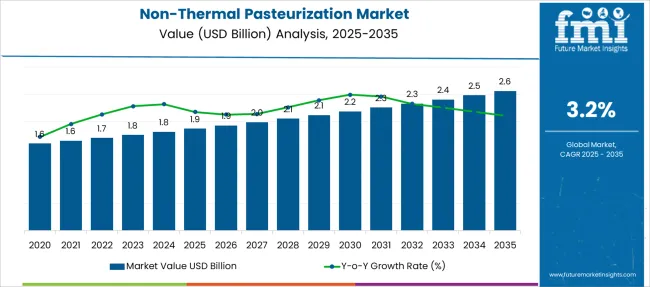
| Metric | Value |
|---|---|
| Non-Thermal Pasteurization Market Estimated Value in (2025 E) | USD 1.9 billion |
| Non-Thermal Pasteurization Market Forecast Value in (2035 F) | USD 2.6 billion |
| Forecast CAGR (2025 to 2035) | 3.2% |
The non-thermal pasteurization market is expanding due to increasing demand for food safety solutions that preserve nutritional value and flavor. Advances in food processing technology have encouraged the adoption of methods that avoid heat-related nutrient degradation.
Consumers are increasingly seeking fresh-tasting and minimally processed foods, which has led manufacturers to invest in innovative pasteurization techniques. Regulations emphasizing food safety and longer shelf life have also supported market growth.
The rising preference for clean-label and natural products has created opportunities for non-thermal methods. Additionally, expanding applications in beverages and liquid foods have boosted demand. Market growth is expected to continue as the industry adopts more sustainable and efficient processing technologies. Segment growth is projected to be driven by High-Pressure Processing, liquid form products, and the food and beverage sector due to its large scale and diverse product requirements.
The market is segmented by Technique, Form, and Application and region. By Technique, the market is divided into High-Pressure Processing, Pulse Electric Field, Microwave Volumetric Heating, and Ultrasonic, Irradiation. In terms of Form, the market is classified into Liquid and Solid. Based on Application, the market is segmented into Food and Beverages, Pharmaceuticals, and Cosmetics. Regionally, the market is classified into North America, Latin America, Western Europe, Eastern Europe, Balkan & Baltic Countries, Russia & Belarus, Central Asia, East Asia, South Asia & Pacific, and the Middle East & Africa.

The High-Pressure Processing segment is expected to account for 41.2% of the market revenue in 2025, maintaining its position as the leading technique. Its growth is attributed to the ability to inactivate microorganisms while preserving sensory and nutritional qualities. Food producers have favored this method for its efficiency in extending shelf life without the use of heat, chemicals, or additives.
It is particularly effective in maintaining freshness and texture in sensitive products such as juices and dairy. The process also aligns with consumer demand for minimally processed foods and clean-label ingredients.
As research continues to validate its benefits and processing costs decrease, high-pressure processing is expected to remain a preferred choice.

The Liquid form segment is projected to contribute 57.8% of the market revenue in 2025, holding its position as the dominant product form. Liquids such as juices, milk, and beverages have been primary candidates for non-thermal pasteurization due to their susceptibility to heat damage.
The demand for fresh, nutrient-rich drinks has driven producers to adopt technologies that extend shelf life while preserving taste and nutritional content. Liquid products benefit from the uniform application of pressure or other non-thermal techniques, resulting in effective microbial reduction.
Increasing consumer preference for healthy beverages and functional drinks supports the growth of this segment. Innovations in liquid processing equipment and scalability also enhance adoption.
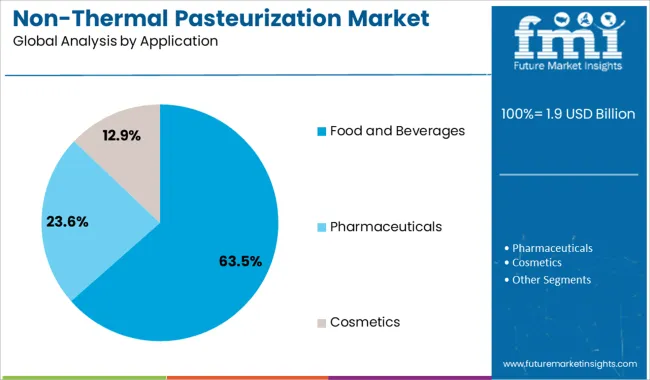
The Food and Beverages segment is projected to hold 63.5% of the market revenue in 2025, representing the largest application area. Growth in this segment is driven by the rising consumption of minimally processed, fresh, and clean-label food products.
The industry’s focus on extending product shelf life without compromising quality has heightened demand for non-thermal pasteurization methods. The diverse product portfolio within food and beverages, including juices, dairy, and ready-to-eat meals, has provided broad opportunities for technology application.
Regulatory pressure to ensure safety and reduce foodborne illnesses has further encouraged adoption. As consumer demand evolves towards natural and preservative-free products, the food and beverage sector will continue to be the primary driver of market growth.
| Market Statistics | Details |
|---|---|
| H1,2024 (A) | 3.2% |
| H1,2025 Projected (P) | 3.2% |
| H1,2025 Outlook (O) | 3.5% |
| BPS Change : H1,2025 (O) - H1,2025 (P) | (+) 32 ↑ |
| BPS Change : H1,2025 (O) - H1,2024 (A) | (+) 35.2 ↑ |
An increasing number of cases of foodborne illness are being observed, which is another factor that is expected to cause a great need for non-thermal pasteurization technology to eliminate the potential for food poisoning. Some new developments that have taken place in these market include, PEF (Pulsed Electric Field) is a widely used tool to keep food burning while also extending its shelf life.
It also meets consumers' need for raw, fresh, and processed foods without the use of preservatives or additives. This process helps to preserve the nutrients, colour and taste of food to satisfy the global need for snacks.
The global market for non-thermal pasteurization technology is witnessed H1 2024 growth at magnitude of 3.2%. However, this growth is not evenly spread across all regions, with the developing markets recording higher growth rates of 3.5% (H1 2025 Expected). Thus, leaving the gap of -35.2 BPS points between expected and projected growth during H1 2025.
Non-thermal pasteurization gains market share in North America at a faster rate. Forwarding incorporation is used by producers in the country to increase their participation in the value chain.
The new trend in the industry is expected to be a combination of processes ranging from imports to post-sales services using strategies (Pulsed Electric Field) and HPP (High-Pressure Processing). This is expected to result in high quality and inexpensive finished products that deliver good output and lifetime value.
The increasing demand for the preservation of vegetables, meat, seafood, fruits, and other types of packaged food is driving the non-thermal pasteurization market. People's changing lifestyles and hectic schedules are compelling them to seek out packaged, ready-to-eat, and frozen foods.
Despite this, there is a significant increase in demand for higher quality and healthier items, making non-thermal pasteurization extremely important in the food industry.
Non-thermal pasteurization is gaining popularity as a preferred food processing technology for converting raw food items into products fit for human consumption. Non-thermal pasteurization does not expose the food to high temperatures, which helps to preserve the flavor, nutritional value, and appearance of the food. The technology also aids in the killing of pathogens, thereby keeping food safe.
The growing consumer demand for tastier, safer, and additive-free food is also driving the global market for non-thermal pasteurization. Increased use of high-pressure processors, as well as rising government investments in food processing equipment and machinery, are opening up new opportunities for market growth.
The convenience food category includes ready meals such as ready-to-eat foods, shelf-stable items, and prepared mixes such as cake mix. Pre-cut vegetables, canned and bottled foods, frozen meat, ready-to-cook or ready-to-serve foods, and a variety of other convenience foods are available.
As consumer meal consumption habits change, there is an increasing demand for dinner-time solutions among today's consumers. Many customers are able to invest in the ready-to-eat market because they lack the resources or skills to prepare food at home.
Marketers have used a variety of tactics in recent years, including portion-controlled packaging, in-store promotions, mergers and acquisitions, and health statements on labels. People want food that reduces cooking time and effort, which is driving the Non-Thermal Pasteurization Industry.
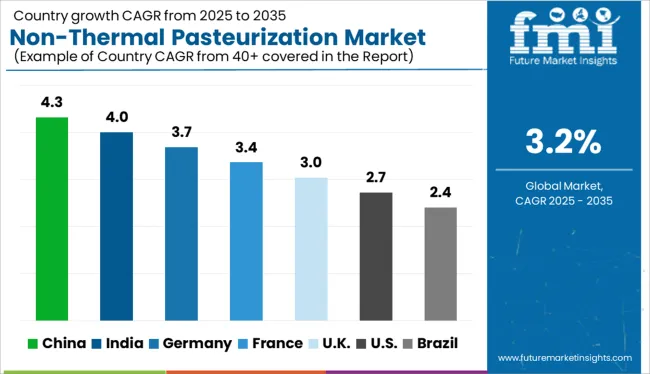
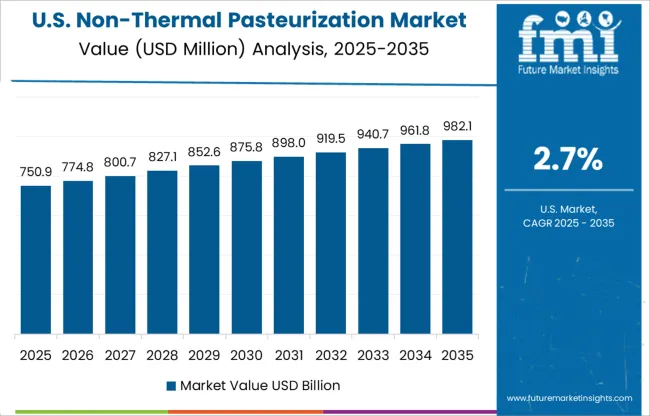
A growing number of food product manufacturers in the USA recognize the value of non-thermal pasteurization. The country also has a high meat consumption rate, which increases growth opportunities for the non-thermal pasteurization market. The country will continue to be profitable, manufacturers are likely to shift their focus to emerging markets as well.
With the Asia-Pacific region's rapid economic growth, demand for meat is increasing, particularly in China. This increased demand for meat products has fueled meat production in this region, contributing to market growth. Consumers' changing busy lifestyles and rising health awareness are also driving the market growth.
The PEF segment is expected to grow at the fastest CAGR over the next five years. This technology maintains the freshness of food products while also extending their shelf life. It also meets consumer demand for natural, fresh, and minimally processed foods because no preservatives or additives are used in the manufacturing process.
Although PEF is newer than HPP, the processed potato industry has accepted it globally. Because of these factors, the market is expected to grow at a rapid pace in the future.
The beverages segment is expected to grow at the fastest rate during the forecasted period. Non-thermal pasteurization processes, such as HPP and PEF, are becoming more popular in the beverage market because they effectively extend beverage shelf life and prevent the development of microbial.
Furthermore, with the help of these colors, technology, nutrients, and flavors can be efficiently preserved. This technology aids in the preservation of nutrients, color, and flavor in products, as well as the gentle preservation of beverages at room temperature.
The solid food form is expected to have a larger market share during the forecasted period. This is because non-thermal pasteurization techniques are used in food products such as jellies, cheese, jam, meat products, processed foods, and so on. However, several technologies such as HPP and PEF are used to improve the extraction of sugars and various bioactive components in order to keep food fresher for longer.
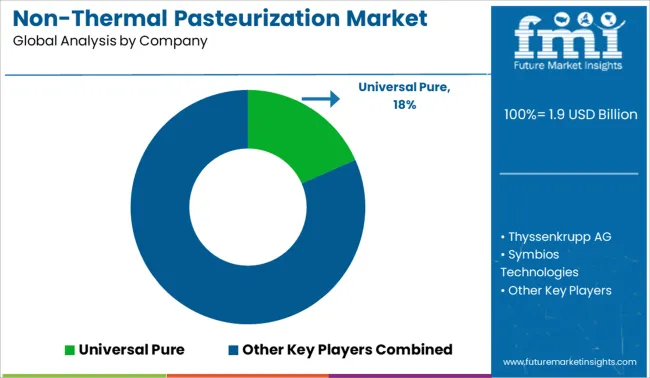
The adoption of novel food processing technologies for the retention of food nutrients and sensory attributes is driving an increase in R&D activities for technology development in non-thermal pasteurization.
| Attribute | Details |
|---|---|
| Forecast Period | 2025 to 2035 |
| Historical Data Available for | 2020 to 2025 |
| Market Analysis | USD Million for Value and Million. Sq. M. for Volume |
| Key Regions Covered | North America; Latin America; Europe; East Asia; South Asia; and the Middle East & Africa |
| Key Countries Covered | USA, Brazil, Mexico, Germany, UK, China, India, Japan, Australia, and GCC Countries |
| Key Segments Covered | Technique, Form, Application, Region |
| Key Companies Profiled | Universal Pure; Thyssenkrupp AG; Symbios Technologies; Stansted Fluid Powder Ltd; Pulsemaster; Nordion; Next HPP; Multivac Sepp Haggenmuller Se & Co. Kg; Kobe Steel Ltd; Hormel Foods; Hiperbaric Espana; Hain Celestial; Elea Technology; Dukane Corporation; Chic Freshertech; Bosch; BaoTou KeFa High-Pressure Technology; Avure Technologies, American Pasteurization; Advanced Microwave Technologies. |
| Report Coverage | Market Forecast, Company Share Analysis, Competition Intelligence, DROT Analysis, Market Dynamics and Challenges, and Strategic Growth Initiatives |
| Customization & Pricing | Available upon Request |
The global non-thermal pasteurization market is estimated to be valued at USD 1.9 billion in 2025.
The market size for the non-thermal pasteurization market is projected to reach USD 2.6 billion by 2035.
The non-thermal pasteurization market is expected to grow at a 3.2% CAGR between 2025 and 2035.
The key product types in non-thermal pasteurization market are high-pressure processing, pulse electric field, microwave volumetric heating and ultrasonic, irradiation.
In terms of form, liquid segment to command 57.8% share in the non-thermal pasteurization market in 2025.






Our Research Products

The "Full Research Suite" delivers actionable market intel, deep dives on markets or technologies, so clients act faster, cut risk, and unlock growth.

The Leaderboard benchmarks and ranks top vendors, classifying them as Established Leaders, Leading Challengers, or Disruptors & Challengers.

Locates where complements amplify value and substitutes erode it, forecasting net impact by horizon

We deliver granular, decision-grade intel: market sizing, 5-year forecasts, pricing, adoption, usage, revenue, and operational KPIs—plus competitor tracking, regulation, and value chains—across 60 countries broadly.

Spot the shifts before they hit your P&L. We track inflection points, adoption curves, pricing moves, and ecosystem plays to show where demand is heading, why it is changing, and what to do next across high-growth markets and disruptive tech

Real-time reads of user behavior. We track shifting priorities, perceptions of today’s and next-gen services, and provider experience, then pace how fast tech moves from trial to adoption, blending buyer, consumer, and channel inputs with social signals (#WhySwitch, #UX).

Partner with our analyst team to build a custom report designed around your business priorities. From analysing market trends to assessing competitors or crafting bespoke datasets, we tailor insights to your needs.
Supplier Intelligence
Discovery & Profiling
Capacity & Footprint
Performance & Risk
Compliance & Governance
Commercial Readiness
Who Supplies Whom
Scorecards & Shortlists
Playbooks & Docs
Category Intelligence
Definition & Scope
Demand & Use Cases
Cost Drivers
Market Structure
Supply Chain Map
Trade & Policy
Operating Norms
Deliverables
Buyer Intelligence
Account Basics
Spend & Scope
Procurement Model
Vendor Requirements
Terms & Policies
Entry Strategy
Pain Points & Triggers
Outputs
Pricing Analysis
Benchmarks
Trends
Should-Cost
Indexation
Landed Cost
Commercial Terms
Deliverables
Brand Analysis
Positioning & Value Prop
Share & Presence
Customer Evidence
Go-to-Market
Digital & Reputation
Compliance & Trust
KPIs & Gaps
Outputs
Full Research Suite comprises of:
Market outlook & trends analysis
Interviews & case studies
Strategic recommendations
Vendor profiles & capabilities analysis
5-year forecasts
8 regions and 60+ country-level data splits
Market segment data splits
12 months of continuous data updates
DELIVERED AS:
PDF EXCEL ONLINE
Milk Pasteurization Machines Market Size and Share Forecast Outlook 2025 to 2035
Beer Pasteurization Equipment Market Size and Share Forecast Outlook 2025 to 2035

Thank you!
You will receive an email from our Business Development Manager. Please be sure to check your SPAM/JUNK folder too.
Chat With
MaRIA